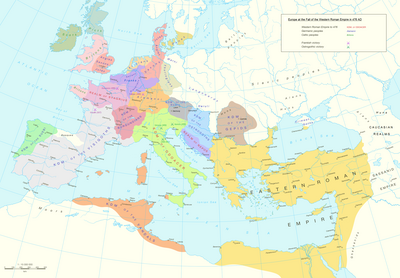
The barbarian kingdoms[1][2][3] were states founded by various non-Roman, primarily Germanic, peoples in Western Europe and North Africa following the collapse of the Western Roman Empire in the fifth century.[1][2][3] The barbarian kingdoms were the principal governments in Western Europe in the Early Middle Ages. The time of the barbarian kingdoms is considered to have come to an end with Charlemagne's coronation as emperor in 800, though a handful of small Anglo-Saxon kingdoms persisted until being unified by Alfred the Great in 886.[4]
The formation of the barbarian kingdoms was a complicated, gradual, and largely unintentional process. Their origin can be traced to the Roman state failing to handle barbarian migrants on the imperial borders, which led to both invasions and invitations into imperial territory. Despite an increasing influx of barbarians, the Romans simultaneously denied them the ability to properly integrate into the imperial framework. Barbarian rulers were at first local warlords and client kings without firm connections to any territory. Their influence only increased as Roman emperors and usurpers began to use them as pawns in civil wars. The barbarian realms only transitioned into proper territorial kingdoms after the collapse of effective Western Roman central authority.
Barbarian kings established legitimacy through connecting themselves to the Roman Empire. Virtually all barbarian rulers assumed the style dominus noster ("our lord"), previously used by Roman emperors, and many assumed the praenomen Flavius, borne by nearly all Roman emperors in late antiquity. Most rulers also assumed a subordinate position in diplomacy with the remaining Eastern Roman Empire. Many aspects of the late Roman administration survived under barbarian rule, though the old system gradually dissolved and disappeared, a process accelerated by periods of political turmoil.
The barbarian kingdoms of Western Europe were for the most part fragile and ephemeral. By the time of Charlemagne's coronation in 800, only his Frankish Kingdom and a few small Anglo-Saxon realms remained out of the once vast and diverse network of kingdoms. Alfred the Great unified the Anglo-Saxons in 886, forming what would eventually be known as the Kingdom of England.[5] Ostrogoths who migrated to the Crimean Peninsula, later known as Crimean Goths, maintained a distinct culture until roughly the 18th century, but little is definitively known about them.[6]
- ^ a b Croke 2003, p. 349.
- ^ a b Kulikowski 2012, p. 31.
- ^ a b Delogu 2002, p. 84.
- ^ "Alfred | Biography, Reign, & Facts | Britannica". www.britannica.com. 4 August 2024. Retrieved 14 August 2024.
- ^ "Alfred | Biography, Reign, & Facts | Britannica". www.britannica.com. 4 August 2024. Retrieved 14 August 2024.
- ^ Khrapunov, Nikita (12 August 2020). "The Crimean Goths in the Russian Imperial and Soviet Periods: In Between of History, Myth, and Politics". Amsterdamer Beiträge zur älteren Germanistik. 80 (1–2): 193–231. doi:10.1163/18756719-12340174. ISSN 1875-6719.